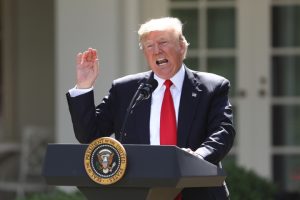Evaluating the statements in Trump’s letter regarding the Paris Agreement on climate change, Trump refers to the United States pledge to reduce greenhouse as an unnecessary financial toll for the American people and states “meanwhile, the [Paris] agreement allows countries such as China to increase their emissions for years to come.” Evaluating quote with Politifact’s Truth-O-Meter, I would have to say the accuracy of this statement is mostly false, meaning it “contains an element of truth but ignores critical facts that would give a different impression” (Adair and Holan).
The statement is accurate in implying that China’s greenhouse gas emission will continue to increase under the pledge stated in the Paris Agreement on September 3, 2016. China’s commitment was to peak carbon dioxide emissions by 2030 at the latest, to lower the carbon intensity of GDP by 60 to 65 percent below the 2005 levels also by 2030, and to increase its forest stock volume by 4.5 billion cubic metres compared to its 2005 levels (“China”). The statement fails to indicant the action that China has taken in terms of climate change. Though the levels of greenhouse gases (GHGs) continue to increase China has become a leader in developing a low carbon power sector. Under the GHG Control and Environmental Protection 13th Five Year Plans, China will be “deepening policies to reduce coal consumption, develop low carbon technologies and policies, and pursue a path towards cleaner development” (Lin).
In the context of the letter, Trump first refers to what the Paris Agreement means to Americans, saying “reducing greenhouse gas emission by 26 to 28 percent below 2005 levels by 2025” would be a “significant burden for American’s workers and families” (Trump). He then implies with a statement about “other countries” expressing his opinion that China is not doing its fair share (Trump). This however fails to mention the historical contribution of the United States to climate change. Looking at the cumulative carbon dioxide emission of countries from 1850 to 2011, the United States leads with 27% of the cumulative world emissions between the period, while China comes in third after the European Union with 11% of the cumulative world emissions (Ge et al). Though China’s contribution to global GHG emission have increased since 2011, the United States cannot forget its historical contribution.

This statement is also misleading because of its weak language like the phrase “increase their emissions for years to come” (Trump). This almost suggest that there are no plans in place to more away from carbon intensive energy sources such as coal. Also by not being specific about China’s pledge in the Paris Agreement, the language belittles the efforts of country with an extremely large population and the efforts it has and is currently taking to reduce its GHG emissions.
Since Trump’s statement, fails to mention the actions China has taken and the historical contribution the United States has in instigating climate change, there are critically key facts that have been left out in this statement. Because of the absence of this information, the statement is misleading in its assumption of China’s lack of contribution in the Paris Agreement. Therefore, the misleading information after evaluation falls under the evaluation of ‘mostly false’ according to Politifact’s Truth-O-Meter.
Works Cited
Adair, Bill, and Angie Drobnic Holan. “The Principles of PolitiFact, PunditFact and the Truth-O-Meter.” PolitiFact, www.politifact.com/truth-o-meter/article/2013/nov/01/principles-politifact-punditfact-and-truth-o-meter/.
“China.” Climate Action Tracker, Climate Action Tracker Partners, climateactiontracker.org/countries/china.html. Accessed May 2017.
Ge, Mengpin, et al. “6 Graphs Explain the World’s Top 10 Emitters.” World Resources Institute, wri.org/blog/2014/11/6-graphs-explain-world%E2%80%99s-top-10-emitters.
Lin, Alvin. “China’s New Plans Deepen Action on Climate Change.” NRDC, Natural Resources Defense Council, www.nrdc.org/experts/alvin-lin/chinas-new-plans-deepen-action-climate-change. Accessed Dec. 2016.
Trump, Donald. Letter. The White House.





 Climate Action Tracker notes emissions over time within the United States, predictions do not include Trumps decision to withdraw from the Paris agreement, as it is not yet effective. The US ranking for climate action regardless, is “Inadequate.”
Climate Action Tracker notes emissions over time within the United States, predictions do not include Trumps decision to withdraw from the Paris agreement, as it is not yet effective. The US ranking for climate action regardless, is “Inadequate.”





